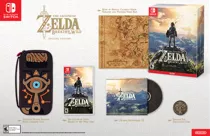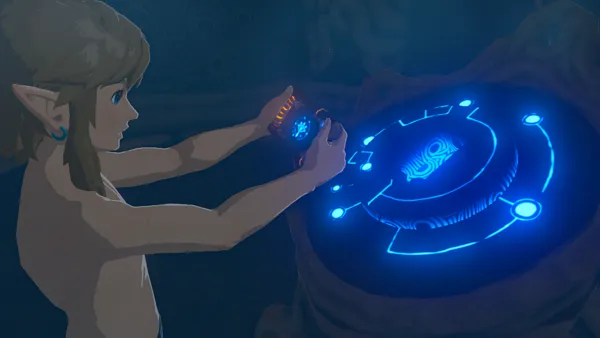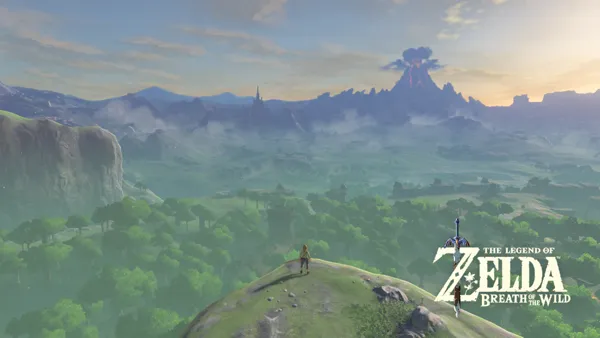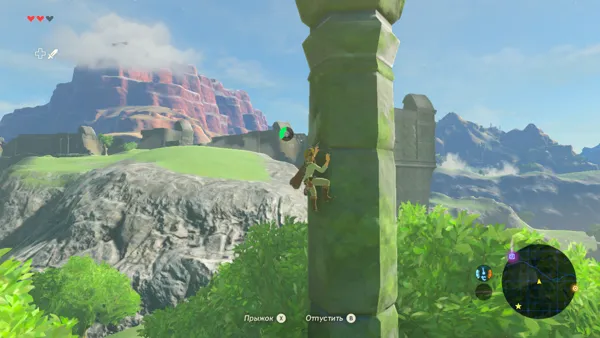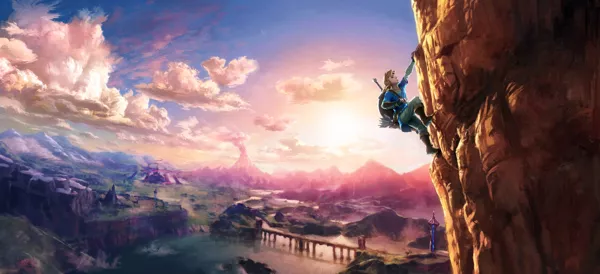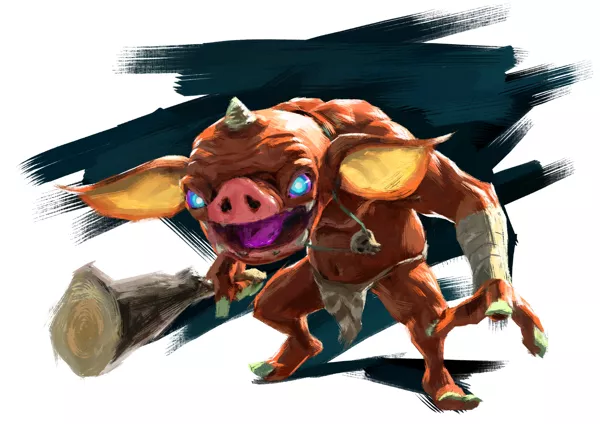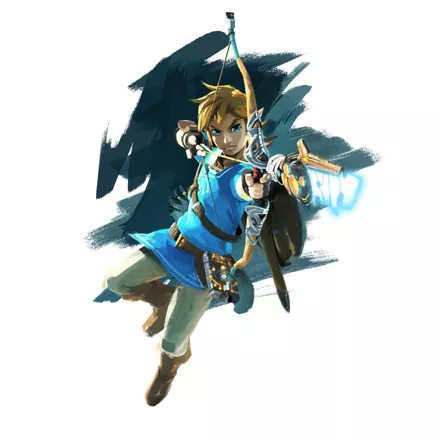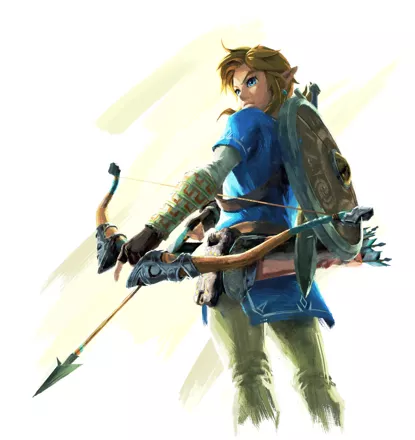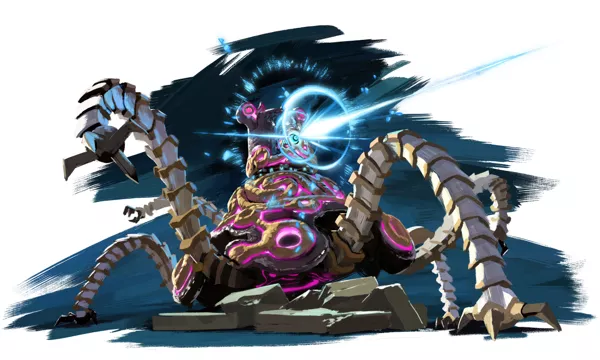The Legend of Zelda: Breath of the Wild
Official Description (Ad Blurb)
Step into a world of adventure
Forget everything you know about The Legend of Zelda games. Step into a world of discovery, exploration, and adventure in The Legend of Zelda: Breath of the Wild, a boundary-breaking new game in the acclaimed series. Travel across vast fields, through forests, and to mountain peaks as you discover what has become of the kingdom of Hyrule In this stunning Open-Air Adventure. Now on Nintendo Switch, your journey is freer and more open than ever. Take your system anywhere, and adventure as Link any way you like.
Features:
- Explore the wilds of Hyrule any way you like—anytime, anywhere!
- Climb up towers and mountain peaks in search of new destinations, then set your own path to get there and plunge into the wilderness. Along the way, you'll battle towering enemies, hunt wild beasts and gather ingredients for the food and elixirs you'll make to sustain you on your journey. With Nintendo Switch, you can literally take your journey anywhere.
- More than 100 Shrines of Trials to discover and explore - Shrines dot the landscape, waiting to be discovered in any order you want. Search for them in various ways, and solve a variety of puzzles inside. The tasks you must perform in each Shrine varies, and you'll never expect the challenges you'll face until you enter. Some will involve realistic physics, and some will require you to harness the power of nature, including electricity, wind, fire, and more. Work your way through the traps and devices inside, utilizing your runes and think outside the box to earn special items and other rewards that will help you on your adventure.
- Be prepared and properly equipped – With an entire world waiting to be explored, you'll need a variety of outfits and gear to reach every corner. You may need to bundle up with warmer clothes or change into something better suited to the desert heat. Some clothing even has special effects that, for example, can make you faster or stealthier.
- Battling enemies requires strategy – The world is inhabited with enemies of all shapes and sizes. Each one has its own attack method and weaponry, so you must think quickly and develop the right strategies to defeat them.
- amiibo compatibility – The Wolf Link amiibo from Twilight Princess HD, the Zelda 30th Anniversary series amiibo, and The Legend of Zelda: Breath of the Wild series amiibo are all compatible with this game. Tap the Wolf Link amiibo (sold separately) to make Wolf Link appear in the game. Wolf Link will attack enemies on his own and help you find items you’re searching for. Tap a Zelda 30th Anniversary series amiibo to receive helpful in-game items or even a treasure chest!
Source: Nintendo.com Description
Spellings
- ゼルダの伝説 ブレス オブ ザ ワイルド - Japanese spelling
- 젤다의 전설 브레스 오브 더 와일드 - Korean spelling
Groups +
- Console Generation Exclusives: Nintendo Switch
- Console Generation Exclusives: Wii U
- Fantasy creatures: Dragons
- Gameplay feature: Alchemy
- Gameplay feature: Armor / weapon deterioration
- Gameplay feature: Armor / weapon sets
- Gameplay feature: BASE jumping
- Gameplay feature: Day / night cycle
- Gameplay feature: Fishing
- Gameplay feature: Game completion percentage
- Gameplay feature: Horse riding
- Gameplay feature: House ownership
- Gameplay feature: Hunting
- Gameplay feature: Interior decorating
- Gameplay feature: Mining
- Gameplay feature: Photography
- Gameplay feature: Survival cooking
- Gameplay feature: Time manipulation
- Games that pay tribute to a deceased person
- Japanese Nintendo Switch games with full English support
- Launch title: Nintendo Switch (Japan)
- Legend of Zelda series
- Protagonist: Elf
Screenshots
Promos
Videos
See any errors or missing info for this game?
You can submit a correction, contribute trivia, add to a game group, add a related site or alternate title.
Credits (Wii U version)
946 People (914 developers, 32 thanks) · View all
Reviews
Critics
Average score: 95% (based on 88 ratings)
Players
Average score: 4.5 out of 5 (based on 86 ratings with 6 reviews)
The Good
* Vast, rich world to explore
-
Great traversal mechanics
-
Cool physics system
-
Fun sandbox combat and puzzles
-
Survival and stealth add layers to the gameplay
The Bad
* Frame rate and performance issues
-
Lackluster dungeons
-
Basic side quests
-
Small enemy variety
-
Unbalanced economy
The Bottom Line
It’s finally here. After what feels like a lifetime (really just five years ago), the newest 3D console Zelda has arrived. Heralding the arrival of a new system, while also sending off the previous era, The Legend of Zelda: Breath of the Wild feels like a culmination of everything that Nintendo has learned about “modern” game design, and a vision for what their future might hold.
It’s difficult to talk about Breath of the Wild without mentioning the legacy of the consoles it’s being released on. It represents an ending for one system, and a beginning of another. For the Wii U, this is its swan song, one last hurrah to showcase the Wii U’s capabilities before being put out to pasture. It’s very fitting too, as 2011’s Skyward Sword served essentially the same role for the Nintendo Wii. For the Switch, this is its killer app, a showcase of the system’s ability to take full-featured console games wherever you go.
Breath of the Wild opens with Link waking up in a cave atop the Great Plateau in Hyrule. Link has been asleep in a technological pod for 100 years, having somehow retained his age, with no recollection of who he is or how he got there. During this time, Hyrule has been overrun by robotic machines called “Guardians”. Meanwhile, Ganon festers in the distance at Hyrule Castle in the form of a dark black cloud, a reminder of what you’re up against pervading throughout the game. Evil has won, and Link will have to reassemble both the shattered remnants of a broken Hyrule, as well as his own memories, if he is to succeed in his mission of defeating Ganon, rescuing Zelda, and saving Hyrule (yet again).
Breath of the Wild’s storytelling is very different from the other games of the series. Much of the story actually takes place in flashbacks, as Link uncovers his memories. You have to seek out the cutscenes, which may not be presented in order, rather than have them happen in a linear fashion. The other major change is the addition of full voice acting for some of the cutscenes. Most of the game still uses the classic text boxes, but every once in a while, the game will break the silence with actual words. Link still retains his trademark muteness, but characters such as Zelda and Impa are finally given chances to speak. I thought the voice acting was pretty good for the series’ first attempt. Admittedly, some of the voices are rather cheesy, but there’s something just plain cool about hearing characters actually speak in a Zelda game. Zelda in particular gives a solid performance - she is by far the game’s most complex character, and though you are playing as Link, this is really Zelda’s story at its core. There were a few key characters that I found supremely annoying, and there was a general lack of twists and dramatic moments that made the previous games so special. It is, in the end, a pretty straightforward tale, despite its fragmented nature. Despite the problems I had with the story, I still enjoyed it overall.
Just before leaving the Shrine of Resurrection, Link acquires a tablet-like device called the “Sheikah Slate”, which looks suspiciously like the controller or device you might be playing this game on. This device functions as a map, as well as a scope. In addition, the various apps on the slate, called “runes”, allow for similar functionality to the items that were seen in previous Zelda games. Bombs come in two flavors (round and cube) and are now manually detonated. Magnesis lets you pick up and manipulate metal objects from a distance. Stasis stops an object in time, allowing you to hit it with something to store up momentum when it releases. Cryonis creates pillars of ice from water. You’ll utilize these runes for traversal, puzzle solving, and occasionally combat. Later on, you’ll also unlock the Sheikah Sensor and Camera. The former lets you seek out shrines and other items which you might be looking for, while the latter lets you take pictures so you can catalog items, monsters, and characters in your tablet’s compendium. This will allow you to set your sensor to search for them later.
Shrines are found throughout Hyrule. Some shrines can be seen from miles away, while others are hidden, and require special tasks to be completed before they are revealed. Upon completing these shrines, you are rewarded with Spirit Orbs. You can exchange four of these at Goddess Statues to earn an extra heart container or add to your stamina meter. Many of the shrines have puzzle/platforming challenges that must be solved. These challenges often have optional treasure chests that are more difficult to get to than simply solving the shrine. Other shrines offer combat challenges against smaller Guardians. These are fairly fun and are worth fighting for the weapons and gear they guard, but they all use the same three tactics making them a bit too easy once you know their tricks. There are also some shrines where the “challenge” is completed in the overworld, and give you a spirit orb just for showing up. It seems like the farther I got in the game, the more I came across the latter two types of shrines, when I had wanted to see more of the former. Also, all of the shrines have the exact same look and feel, which makes sense thematically but can feel repetitive as the game wears on. Nevertheless, I was absolutely hooked on finding these things throughout the entire adventure.
It’s not clear until shortly after you leave the Great Plateau, but this game is utterly massive in size. It’s rumored to be around 12 times the size of Twilight Princess, which was already a large game by Zelda standards. It’s not just that there is a wide swath of land to explore, but it’s absolutely dense with variety. There are so many different types of environments, from grassy fields, to snowy mountains, sandy beaches, and hot deserts and volcanoes. If you see something in the distance you can go to it, and you’ll often be rewarded for doing so. There are also more towns in this than in any other 3D Zelda game, each with their own characters, shops, and side quests. The other reason this game feels so big is that you can explore in any direction. You are never forced to follow the main quest, and are free to visit even the toughest areas upon leaving the Great Plateau. You can even head straight to Ganon and try to kill him, if you so desire. Or, you can spend hours out in the world, hunting for shrines, monsters, side quests, gear, and other surprises. The game leaves it all up to you.
At the heart of all of this is a surprisingly rich simulation of physics, chemistry, and AI. This is a world driven by physics. You can push boulders and watch them roll down hills. Wind will push rafts along water surfaces. Grass and wooden objects burn. Trees can be chopped down. Ropes can be cut. You can tie balloons to objects to make them float. There are so many cool things you can do with Breath of the Wild’s physics engine. This can lead to some very surprising emergent gameplay situations.
For example, boomerangs in Breath of the Wild are physics objects - you’ll have to hit a button to catch them once they come back to you. However, if an enemy throws one at you, you can catch it and throw it back at them. It’s a simple example, but it shows just how much this physics engine adds to Breath of the Wild.
This physics engine transforms the way the game’s puzzles are designed. In past games, there would only be a very specific way of solving each puzzle. In Breath of the Wild, it’s possible to “break” many of the game’s puzzles since they are driven by physics. For example, one puzzle has you rolling a ball through a maze by tilting the Gamepad. Many players have reported that you can simply turn the controller upside-down instead and move the ball over to the goal on the right. Either way, as long as the ball gets to the goal, the puzzle is solved. It really frees up the way the puzzles work. Many of the game’s best moments come from solving these puzzles in ways that the designers didn’t intend due to having limited resources to solve them.
There are also survival elements infused into Breath of the Wild’s exploration. There’s nothing too hardcore like sleep or hunger meters, but the game has definitely taken a page from the likes of Don’t Starve, Minecraft, and even Metal Gear Solid. You can collect various plants, mushrooms and critters, and can also hunt for meat and fish (sadly no “fishing”, you catch them with your bare hands). You can then cook these into different foods and elixirs which will heal you and/or give you certain buffs for a given length of time, depending on both the number of ingredients and how many different types you used. For an example, it’s possible to cook a food which will significantly raise your defense for a short amount of time, allowing you a better chance to take on some of the game’s tougher enemies. You’ll also find different pieces of gear that offer the same types of buffs, and you’ll constantly be switching based on the situation. This gear can even be upgraded to offer better damage protection, and other special bonuses.
Weapons, bows, and shields break if they are used too much or take a lot of damage. Though this mechanic has been used in other action role-playing games, the weapons in this game are so brittle that they break after just a small handful of uses. You can use this to your advantage in combat since weapons deal twice the damage when breaking. Link also has a limited inventory, and you’ll have to defeat enemies to replace your inventory with better gear over time. You can eventually upgrade your inventory later in the game, but your space is quite limited from the outset. Nothing is permanent, and you’ll need to use your resources wisely if you go up against tougher enemies. If a weapon is about to break, you can throw it at an enemy for extra damage. You can even knock an enemy’s weapon out of their hand, then pick it up and use it against them.
You’ll also have to pay attention to a temperature gauge, as certain areas of the map are really cold or really hot. When you reach these areas, you’ll have to either find specific clothes which allow Link to survive in harsh conditions but afford less defense, or cook recipes to make Link warm or cool. In addition, changing weather conditions also play a role. Rain can make climbing incredibly difficult without the right gear or a lot of stamina, since surfaces will be too slick to hold for long. Fog can make your next objectives difficult to see. Thunderstorms bring lighting, which is attracted to metal weapons, so you’ll need to switch things out.
There is even a stealth system, and though it’s more rudimentary than a dedicated stealth game would be, it’s also surprisingly more robust than you might expect from a series that was never about stealth in the first place. There is a meter near the temperature gauge that shows the amount of noise Link is making. You’ll need to crouch down and move slowly to reduce the noise, or use a stealth buff. Enemy AI has different states of alertness, and can react to sounds made from Link’s arrows or clothes. Detection works on a line-of-sight system. You can try climbing around an enemy or crouching through the grass to try and sneak around them. It’s also possible to do a stealth attack on an enemy for a lot of damage. You can even sneak into enemy camps at night and slaughter them in their sleep. It’s really quite cruel, but it’s amazing the game even lets you do this at all.
Rolling is now gone - this has been replaced by sprinting, climbing, and jumping. It’s a good thing too, since there are (almost) no invisible walls in Breath of the Wild. Most surfaces can be climbed up, simply by jumping into a surface and holding a direction. You’ll have to pay attention to Link’s Stamina Meter when climbing up surfaces. If it runs out Link will lose his grip and fall. Steeper surfaces cause Link to climb slower, which wastes more stamina, so you’ll want to look for flatter surfaces when scaling a cliff or mountain. You can also glide for very long distances using the paraglider. These mechanics make traversing Breath of the Wild’s world extremely satisfying.
Breath of the Wild’s overworld is far and away the best the series has ever offered. Unfortunately the game’s 4 main dungeons are a minor disappointment compared to previous games. They certainly sound cool on paper: each dungeon consists of the inside of a giant mechanical animal called a Divine Beast. You need to free each Beast of Ganon’s corruption by activating various terminals inside of the Beast, then fighting a boss. In practice, they range from quite decent to underwhelming. None of them would rank among the best dungeons from previous games, including the 2D Zeldas. Rather than opt for a lengthy series of puzzle and combat chambers, the Divine Beasts are instead compact, interlocking series of puzzles. To solve them, you manipulate various parts of the Beast using the Sheikah Slate, along with using your runes, weapons, and glider to reach the terminals. For example, one Beast contains three central chambers that can be rotated independently in 90 degree increments. It’s like climbing inside (and outside) of a giant puzzle box. Unfortunately, enemy variety is extremely limited inside of these dungeons. You will only run across small Guardians and purple gunk called “Malice”. They never take particularly long to solve, either. The boss fights are enjoyable, but while they all use different attacks they all are based off of the same design, greatly diminishing the sense of surprise. I sometimes found that the buildup and quests for entering these mechanical monstrosities were far more tense, funny, and memorable than actually solving them once inside. That’s not to say there weren’t some moments of brilliance in the Divine Beasts, but Breath of the Wild’s “dungeons” simply aren’t as much of a highlight here, unlike past Zelda games, and that’s a real shame.
I have a few more issues, though these aren’t as pressing. The economy in this game feels off. You can find rupees in chests or earn them by completing side quests, but you can earn so much more at once by just selling the gems in your inventory. It’s a good thing that there are so many things to spend them on in this game, and the annoying wallet upgrades that plagued previous games are gone here. Side quests are mostly pretty basic - some of them are simple fetch quests, while others teach you something about the world you might not have initially picked up on. There are a few that are more in-depth, but this isn’t Majora’s Mask in terms of its side quests. Enemy variety is surprisingly lacking when considering how many iconic enemies the Zelda series has. It gets really old to fight tougher, skeletal, and elemental versions of the same few enemy types, over and over. Finally, the final boss is impressive in terms of presentation but is a somewhat easy fight - especially if you complete all of the Divine Beasts before facing Ganon. There are standard enemies in this game that are tougher than he is, honestly. Ganon himself has absolutely no dialog and no character beyond just being a giant purple monster that you have to kill just because he is evil.
Graphically, Breath of the Wild is up there with the best on Wii U, which really isn’t a major surprise as Nintendo are the only developers willing to make a massive, open-world game (really any game with a substantial development effort) for their system. Nevertheless, it looks great. The pastel colors and blur effects greatly remind me of Skyward Sword, but with a slightly more realistic look overall. Every region has a distinct feel to it. The weather effects are often stunning, and characters have a lot of personality in the way they move and react to both Link and the environment. The art style sits somewhere between Skyward Sword and Twilight Princess in its overall look and feel. In comparison to most games released on the other consoles, Breath of the Wild inevitably appears dated. Textures are sometimes shockingly low-resolution, with poor filtering, and the frame rate really struggles in town areas with a lot of NPCs, as well as forests and one of the Divine Beasts. The draw distance for animals, enemies and characters is also quite small. There are enough hills, valleys and walls in Hyrule that you won’t notice this too often, but it can be jarring when it happens. There were even times, when fighting a specific enemy type, when the game would lock up for a bit before resuming. Nevertheless, while these issues aren’t entirely excusable, I still admire games like Breath of the Wild that make underpowered hardware punch above its weight. Draw distance for terrain is extremely vast, and the robust physics engine is something I would have never expected to see in any Wii U game. I never saw any really major glitches either, which is surprising as open-world titles are notorious for their bugs.
The Zelda franchise is highly regarded for its music. Breath of the Wild seems to have a different feel. It relies less on the big, grandiose themes of past installments in favor of more minimalistic pieces, which are subtly layered over the environmental sounds. You’ll definitely hear more than a few snatches of the classic Zelda themes if you play long enough, but for the most part the game relies on its newer, mostly ambient soundtrack. Not much really stands out as being super memorable, though I found the music to be pleasant when it actually bothers to kick in. Surprisingly this is actually the first 3D Zelda game without an “instrument” item to affect the world - no ocarina, no baton, no harp, not even howling.
Breath of the Wild is an ambitious and impressive title that showcases Nintendo at the very top of their game once again. There were admittedly very few titles worth getting excited about on the Wii U, but thankfully this turned out to be one of them, even if it ultimately had to share it with its successor. Nintendo set out to break Zelda conventions with Breath of the Wild. Its physics-driven gameplay, vast open world, and loose storytelling represents a major departure for the series, which was for the most part a success. I personally like the Link to the Past / Ocarina of Time Zelda formula a bit more, but it’s mostly because it’s what I grew up playing, and I would love to see a marriage of these two approaches to Zelda in the future. Nevertheless, there’s lots of room for growth here, and in the end this is a stunning new foundation for my favorite series.
Wii U · by krisko6 (814) · 2017
The Good
It is a masterpiece, with amazing story, gameplay, and everything. It also had immersive details and no lag
The Bad
Graphics were sometimes underwhelming, and I couldn't mod it, just kidding
The Bottom Line
Even with the switch's limitations, it was the best experience, even topping the playstation
Wii U · by June Lee · 2023
The Good
The open world. I have spent more than 100 hours on this game easily
The Bad
the graphics not next gen
The Bottom Line
The best zelda game for the nintendo switch platform.
Nintendo Switch · by adamo · 2023
Trivia
Tribute
The game pays tribute to late Nintendo president Satoru Iwata through the character Botrick, who bears a striking resemblance to Iwata. Botrick tells Link about the Satori Mountain, with "Satori" being derived from Iwata's first name Satoru. At top of the mountain is a mystical horse called the Lord of the Mountain, whose Hyrule Compendium entry reads:
"This noble creature watches over all animals that make their homes in the forest. Legends say this holy creature is a reincarnation of a sage that died on the land it now protects. It has an acute awareness of its surroundings, so it seldom appears before people. It's also known by its other name, Satori."
Delay
The game was originally announced for a Wii U release in 2015, but was later delayed to a 2016 release as developers felt the game would not be finished for a 2015 release. Early in 2016 it was announced that the game was going to be delayed again to 2017, where it was finally released on not only the Wii U but also Nintendo's new console, the Switch.
Guardian Music
The music that plays during Guardian battles is monotonous due to the length of the battles, with most weaker players being defeated quickly and most stronger players being able to destroy them quickly. Unusually, 1 minute and 13 seconds into the music, the rhythm briefly changes to a slightly more upbeat tune before changing back; Nintendo likely implemented this to ensure the music doesn't sound monotonous in the event that a player somehow manages to drag out a Guardian battle for a very long time, but it means that most players will never hear this tune.
The End of an Era
The game was the final Nintendo game to be released on the Wii U.
Awards
- The Dragon Awards
- 2017 – Best Science Fiction or Fantasy PC / Console Game – Won
- The Game Awards
- 2017 – Game of the Year – Won
- 2017 – Best Game Direction – Won
- 2017 – Best Art Direction – Nominated
- 2017 – Best Score / Music – Nominated
- 2017 – Best Audio Design – Nominated
- 2017 – Best Action/Adventure Game – Won
Analytics
Upgrade to MobyPro to view research rankings!
Identifiers +
Contribute
Are you familiar with this game? Help document and preserve this entry in video game history! If your contribution is approved, you will earn points and be credited as a contributor.
Contributors to this Entry
Game added by Harmony♡.
Additional contributors: Havoc Crow, Rik Hideto, firefang9212, Deleted, Shiho Takamori.
Game added March 3, 2017. Last modified March 26, 2024.




